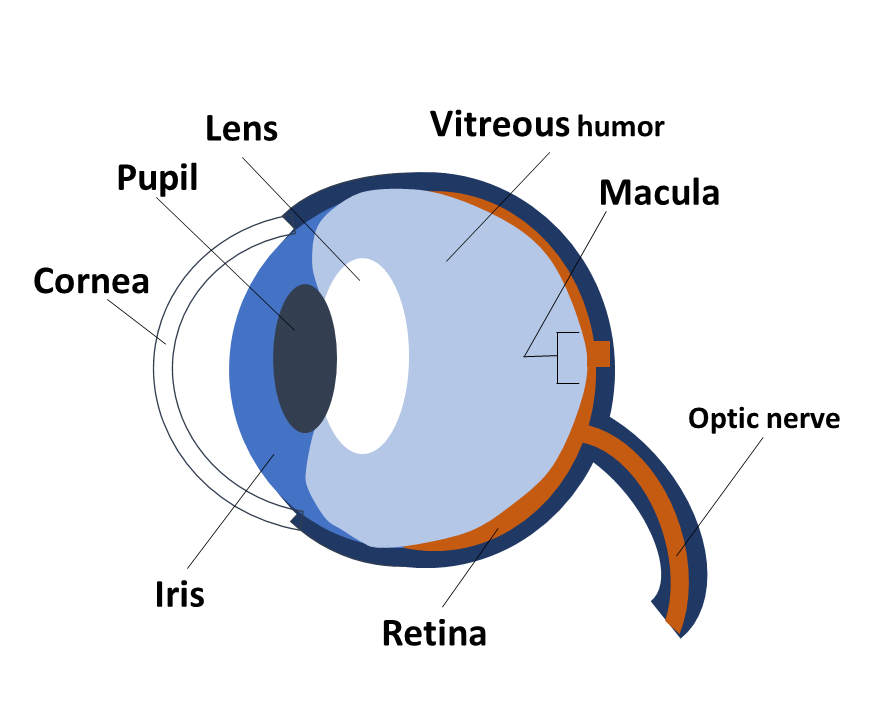HOW THE EYE WORKS

Light rays enter the eye through the cornea—the clear surface of the eye. The shape of the cornea bends light rays so they can enter the pupil. The iris is the coloured part of the eye. The iris controls how much light enters the eye through the pupil.
Light passes through the pupil to the lens. The lens is clear and flexible. The lens and cornea work together to focus light on the back of eye.
On the way to the back of the eye, light passes through a clear gel-like substance called the vitreous. The vitreous fills the eyeball and helps the eye hold its shape.
Light comes to a sharp focus on a thin layer of cells at the back of the eye called the retina. The retina is made up of special cells. One of the most important types of retina cells are photoreceptor cells. Photoreceptors sense light rays and turn this information into electrical signals.
These electrical signals travel from the retina through the optic nerve to the brain where the brain analyzes this information and creates images.
HOW DO EYE DISEASES AFFECT THE EYE?
Developmental problems, injury, or breakdown of any part of the eye can lead to changes in vision and vision loss. Each part of the eye works to turn light into images. If one or more parts of the eye are not working properly, the light information that our brain receives may change or not arrive at all.
Some of the most common eye diseases including age-related macular degeneration, diabetic retinopathy, glaucoma, and inherited retinal diseases are caused by damage to cells in the retina.
The video below explains more about retinal eye diseases.
HOW WE MEASURE VISION
Eye doctors use certain measurements to explain how much we see compared to other people. There are many tests that doctors can perform. Generally, these tests are measuring one or more of the following:
- How well you can see things that are close to you.
- How well you can see things that are far from you.
- How well you can see things that are not directly in front of you.
- How well your retina is functioning, including the number of photoreceptors you have.
- The health of blood vessels in your eye.
- The health and function of your optic nerve.
- The overall health of your eye.
WHAT IS VISUAL ACUITY?
Visual acuity (VA) describes your ability to see sharp images at a specific distance. VA is measured by looking at an image (usually letters on an eye chart) from a specific distance. 20/20 is considered “normal” VA and means that your ability to see an object from 20 feet away is “normal”. If your VA is 20/100, this means you must be 20 feet away to see an image that most people can see from 100 feet away.
People who have less than 20/20 VA can sometimes get glasses or contact lenses to correct their vision. The visual acuity you have with corrective lenses is called best corrected visual acuity (BCVA).
Visual acuity can change over time as the shape of your eye changes. VA is measured as part of a standard eye exam. It is important to have your VA tested regularly to catch any changes in vision or identify if you require glasses or contact lenses.
WHAT IS VISUAL FIELD?
Visual acuity measures how clear your sight is, while visual field measures the range of your vision. Your visual field includes central and peripheral (side) vision.
A visual field test can help your eye doctor measure any blind spots you have, and if they have gotten larger over time.
What does it mean to be legally blind? Legal blindness is determined using measurements of visual acuity and sometimes visual field. A person may be categorized as legally blind if their best corrected visual acuity (as described above) is 20/200 or less in the better eye (sometimes visual acuity is different in each eye). In some cases a person may be classified as legally blind if their visual field is extremely small (less than 20 degrees).
Helpful Links
If you have eye health related questions, contact our Health Information Line at 1-888-626-2995 or healthinfo@fightingblindness.ca.
Join the Fight!
Learn how your support is helping to bring a future without blindness into focus! Be the first to learn about the latest breakthroughs in vision research and events in your community by subscribing to our e-newsletter that lands in inboxes the beginning of each month.






